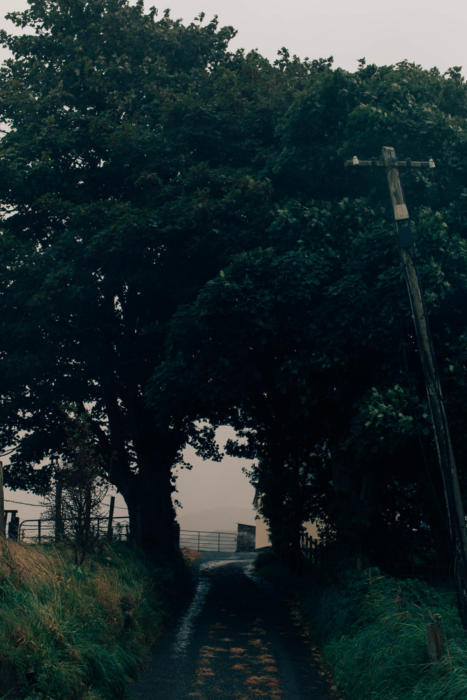 In our voluminous Guide to Cloth series, we’ve already done an article on tweed. But that was about the history, the style and a little about the types. There was no mention of bunches.
Today’s article takes on that introduction, fleshes out the categories and expands into recommendations. In particular, it explains what makes one tweed different from another. While Harris and Shetland tweeds might be quite different, the Harris bunches from the various mills often are not.
A further compliment to this series might be a breakdown of the various tweed jackets I’ve had made over the years, with my reflections and advice. Let me know if you that would be welcome.
In our voluminous Guide to Cloth series, we’ve already done an article on tweed. But that was about the history, the style and a little about the types. There was no mention of bunches.
Today’s article takes on that introduction, fleshes out the categories and expands into recommendations. In particular, it explains what makes one tweed different from another. While Harris and Shetland tweeds might be quite different, the Harris bunches from the various mills often are not.
A further compliment to this series might be a breakdown of the various tweed jackets I’ve had made over the years, with my reflections and advice. Let me know if you that would be welcome.
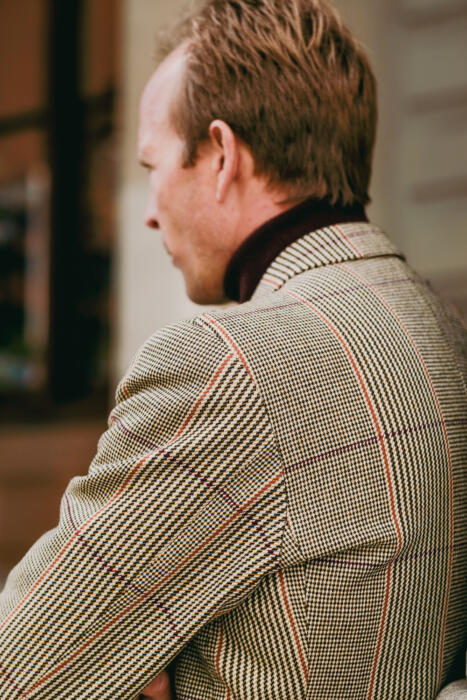
Shooting tweeds
Historically, tweeds were mostly used for suits, including those specifically intended for rural sports such as hunting. This type of tweed is quite different to the soft tweed jacket you’d think of today – it’s denser, sharper, tougher. This a separate category of tweed, and the main bunches are: Porter & Harding: Hartwist Probably the most popular shooting tweed around Savile Row today. Like other shooting tweeds, it’s a woollen but uses a twisted yarn, and is densely set to achieve that toughness. This is what makes a tweed suit something that is functional, that in particular works for trousers. HFW: Alsport This was the default bunch for many years, but the bunch changed slightly in 2007 and was reissued by Huddersfield Fine Worsteds. The new bunch is no longer woven in-house and has a design range more similar to other bunches. Porter & Harding: Thornproof Like Solaro, Thornproof is a trademark and refers to this particular bunch, but the name is so evocative that it is sometimes used as an almost generic name for this type of tweed. Thornproof has some lighter weights than Hartwist and has fewer checks – it’s a muddier, slightly more urban range with some Donegal-like options. The variation between these bunches is mostly one of weight and patterns. Lovat Mill: The Ettrick One of the reasons the bunches don’t vary much is that today the vast majority are woven by the same couple of mills, of which Lovat is one. Lovat bunches are less available and often less supported (meaning the cloth is not being held waiting for someone to order a cut length – these are all things that make the merchants valuable). But Ettrick is a little different, being particularly tough and having a nano coating to help with waterproofing. Tevist and Kirkton are more regular bunches. Glenlyon An old Scottish mill that was bought up and kept going to make its original patterns, Glenlyon has a slightly different handwriting from the others in this list – different colours, some of them lovely, some of them less so. They also have I think the heaviest tweed on the market (775g). Johnstons of Elgin also have some shooting tweed by the cut length, but it’s sometimes avoided by tailors as it’s commonly seen in ready-to-wear. Dugdale’s also has a bunch called White Rose Sporting Tweed, while Holland & Sherry offers the type as Moorland Tweed. Campbells of Beauly is the best place in Scotland for shooting tweeds and often has old lengths.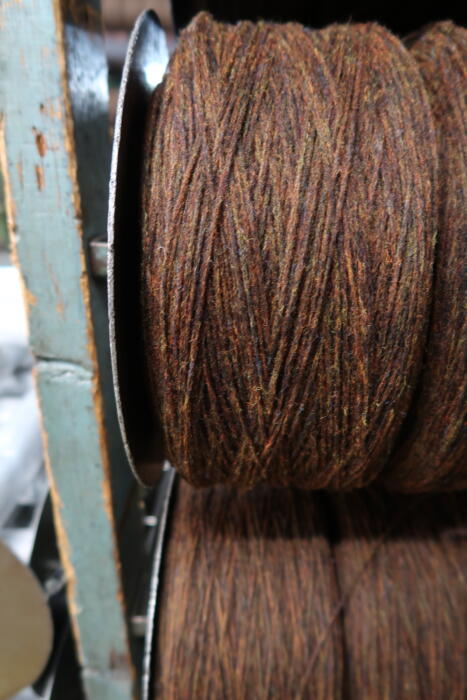
Harris Tweeds
Harris Tweed is protected in terms of where it can be produced and how. But nonetheless, the tweed itself has changed over time with the local sheep – it is nearly all Cheviot today, rather than the original Scots Blackface of the crofters. This makes the tweed softer, quite apart from other changes in mechanisation (see artisanal section below). But, in general Harris Tweed is still hairier – tweedier – than other tweeds you can buy by the cut length, particularly the other obvious jacketing options. Harris Tweed is the first place I would always look for a real tweed jacket. Comparing them to shooting tweeds is rather like comparing woollen to worsted flannel: the latter is very functional but lacks the texture and character of the former. W Bill Porter & Harding and W Bill were the two traditional tweed houses but are now both owned by Harrisons/LBD – another sign of how the world has amalgamated and narrowed. Still, Bill does still offer something slightly different, with patterns that reference the archive and so are more traditional, plus a lighter finish on the material generally, making them more three dimensional. It’s closer to a traditional tweed than most. Holland & Sherry Apart from W Bill and the small artisans we’ll get to later, most Harris tweeds are pretty much the same, and indeed woven in the same places. Holland & Sherry is one of those, but I list it first because it’s often the most accessible for people, and historically has had a broad colour range. Also, it should be said that while traditionalists dislike the softness and more pressed finish of these tweeds, they are more commercial for a reason, being easier for most people in most places to wear. Porter & Harding, Huddersfield Fine Worsted etc There are a few other Harris Tweed bunches out there and the quality is the same, but they don’t usually offer anything apart from an occasional colour. In terms of quality by the way, they will often be described as ‘handwoven’. This means a pedalled loom is used to weave it, but arguably the bigger difference is the loom itself and the size of the wooden shuttle. The artisanal names mentioned lower down are different.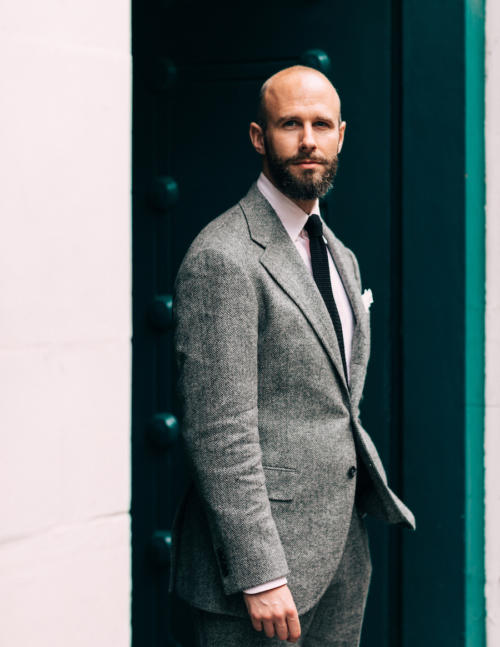
Shetland and other soft tweeds
Shetland wool is softer than cheviot and so shetland tweeds and their like tend to make softer and lighter jackets – better for urban use and frankly the majority of modern use. A lover of tweed might call them flat, lacking character, but make up your own mind. W Bill: Shetland Tweed The default again, although the difference compared to other bunches is less with the Harris, in terms of patterns and feel. Holland & Sherry: Sherry Tweed Uses a New Zealand lambswool rather than shetland, but is similar, just a touch smoother in feel. As with Harris tweed, Holland & Sherry is also often the most accessible around the world for this type of jacking and has a wide range. I’ve used it for jackets in the past and they’ve served me well. Fox Brothers: Fox Tweed Fox Tweed uses a crossbreed British wool that feels quite similar to shetland, but the quality is s heavier and denser than others, coming in at 17/18 ounces. Where Fox Tweed really shines though, is in its colours and patterns. Personally I think it’s the most modern and tasteful selection out there, with a mix of original designs, standards, and twists on them (a particular purply brown comes up a lot). The bunch also stands out given how narrow the tweed market has become in recent years. Abraham Moon Moon are unusual in producing some of their own tweeds in Yorkshire, where most of these come from the same mills. I tend to prefer other bunches, such as those above, but Moon is great when it comes to value for money. Dugdale/Marling & Evans: Undyed wool The popular undyed range from Marling & Evans is now distributed by Dugdale, in a temporary bunch called ‘Undyed British wool jacketing and suiting’. Dugdale also offers a shetland-like tweed under the White Rose Caldonaire label.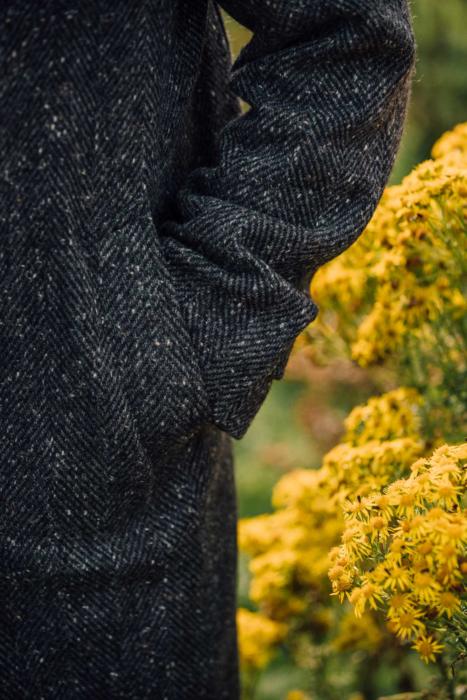
Donegal Tweeds
Donegal Tweed is characterised by flecks of different colours in the cloth, something we’ve seen being made in Donegal (pictured below). However it is not protected like Harris or so clearly defined as Shetland, and so similar designs are seen from various different mills. Molloy & Sons A great mill that we visited for PS here, but hasn’t always sold cloth by the metre. It now offers this through its website – expect a similar handfeel to the shetland and softer tweeds mentioned above. Magee A bigger operation than Molloy and using more modern looms, but often good value for money. The tweeds are often smoother than Molloy or more traditional weavers, which goes to the points above regarding character and choice. Other mills will offer Donegal selections occasionally, usually produced by one of these two or by Nobles, which doesn’t itself sell by the metre.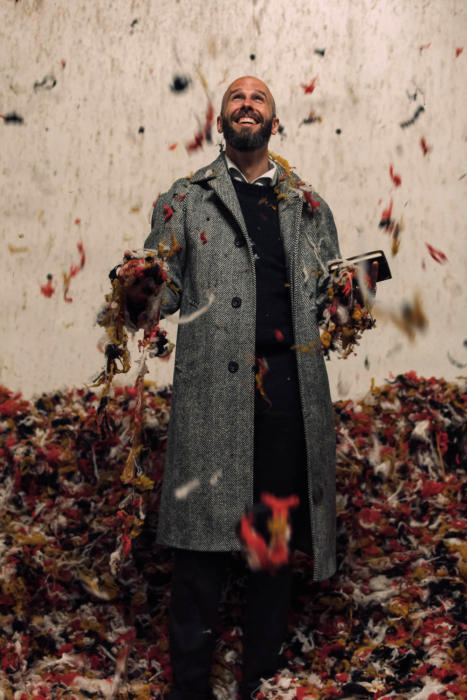 Artisanal tweeds
Old Harris Tweed wasn’t just different because of the wool it used. The old Hattersley looms were also slower, with a big wooden shuttle that worked more space between the yarn and gave it an airy, three-dimensional feel. I worked with Breanish years ago on something related and have seen bolts of the old Harris Tweed at various tailors. They feel like something very different.
There are very few of these weavers left, and those there are don’t usually offer cut lengths (it’s too expensive to keep stock). Ian Sutherland, who used to run Breanish, supplied Anderson & Sheppard for years and his cloth became part of what A&S was known for. Donald John Mackay of Luskentyre Harris Tweed still weaves but nothing is available by the cut length.
One bright spot is Sam Goates of Woven in the Bone, and she occasionally has ends available to buy. And there’s Ardalanish on Mull, who do some cut lengths. They have more modern looms but focus on undyed wools from a range of sheep, or natural dyes such as wode.
If you get a chance to see old Harris Tweed somewhere, it’s worth a look as a reminder of where the material came from – why those cloths could easily make a tough shooting suit, where are a modern Harris could not.
Artisanal tweeds
Old Harris Tweed wasn’t just different because of the wool it used. The old Hattersley looms were also slower, with a big wooden shuttle that worked more space between the yarn and gave it an airy, three-dimensional feel. I worked with Breanish years ago on something related and have seen bolts of the old Harris Tweed at various tailors. They feel like something very different.
There are very few of these weavers left, and those there are don’t usually offer cut lengths (it’s too expensive to keep stock). Ian Sutherland, who used to run Breanish, supplied Anderson & Sheppard for years and his cloth became part of what A&S was known for. Donald John Mackay of Luskentyre Harris Tweed still weaves but nothing is available by the cut length.
One bright spot is Sam Goates of Woven in the Bone, and she occasionally has ends available to buy. And there’s Ardalanish on Mull, who do some cut lengths. They have more modern looms but focus on undyed wools from a range of sheep, or natural dyes such as wode.
If you get a chance to see old Harris Tweed somewhere, it’s worth a look as a reminder of where the material came from – why those cloths could easily make a tough shooting suit, where are a modern Harris could not.
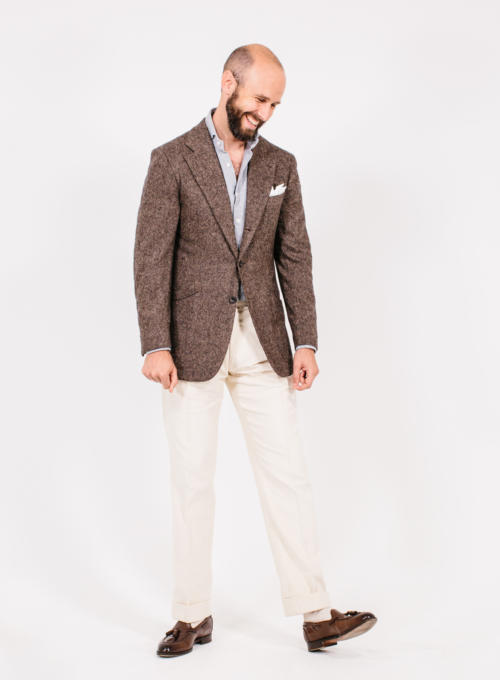 Other tweeds, including Italian versions
There are worsted tweeds such as Glorious Twelfth and Alsport Light, but to me they’re even further away from what tweed should be – basically suitings with a tweed look.
And there are always Italian versions of everything. Some of these are soft wools or even cashmeres with tweedy colours or Donegal flecks (like my Rubinacci jacket, above). But others are more interesting – in Prato they make some lightweight cloths that are deliberately as airy as tweeds, but in softer wools. Perhaps it’s something different to tweed, but it has a definite appeal.
One bunch that I’d certainly recommend in that area is Sopra Visso from Loro Piana, which like all Loro Piana bunches has a very high taste level. It uses local Italian sheep and takes inspiration from tweed designs. Currently there’s only a suiting range but they have also done jacketings.
Other tweeds, including Italian versions
There are worsted tweeds such as Glorious Twelfth and Alsport Light, but to me they’re even further away from what tweed should be – basically suitings with a tweed look.
And there are always Italian versions of everything. Some of these are soft wools or even cashmeres with tweedy colours or Donegal flecks (like my Rubinacci jacket, above). But others are more interesting – in Prato they make some lightweight cloths that are deliberately as airy as tweeds, but in softer wools. Perhaps it’s something different to tweed, but it has a definite appeal.
One bunch that I’d certainly recommend in that area is Sopra Visso from Loro Piana, which like all Loro Piana bunches has a very high taste level. It uses local Italian sheep and takes inspiration from tweed designs. Currently there’s only a suiting range but they have also done jacketings.
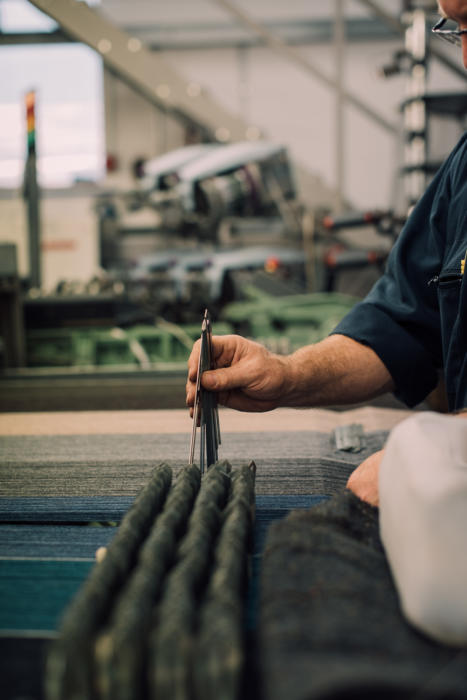




























Please define ‘bunch’. Does it simply mean ‘collection’ or does it mean something else when discussing fabric? I have googled but I cannot find the answer anywhere. Thanks.
A collection of fabrics you can buy by the metre, yes. Contained in a rectangular book usually referred to as a bunch
Thanks for this. My wife and I just spent a leisurely lunch in between Christmas shopping trying to figure out exactly what a bunch is! Every Google search brought up your article and endless articles on tweed (none, of course, as thorough and satisfying as yours), but never the definition of a bunch. We feel better now.
Great and interesting article. I can’t in any way find a reason to buy another sport coat but tus is tempting.
Regarding the “Italian tweeds”. I must put out a warning to the Loro Piana bunch called “Dream Tweed”. It is very soft and nice looking. But it is, based on my own sport coat in that material, more delicate than cashmere or a super-180 suiting. I wouldn’t recommend it to anyone.
It always thrills me when I see a new guide and this one is fantastic.
What about Dugdales Ecology bunch… very nice set of greys!!!
More importantly for me, and if I’ve maybe alluded to this in previous posts ,my apologies, but I want a nice navy jacket to go with my fine grey whipcord trousers; what would you recommend in the above lot …in a plain tweed of fine texture and not too heavy.
Same for a grey jacket?
Thanks
Lindsay
I’d look in the soft tweeds category for that, perhaps a Shetland Tweed. There are some plain navy options in those bunches
hi Simon, I may be a bit biased, but that Russell Check jacket in the first picture is pretty awesome 🙂
I would add that while shooting tweeds like the Russell may not have as much character as a Harris or Shetland, they are enormously practical as they are super hard wearing and do not wrinkle or crease. I use my Russell all the time when I travel over the weekend in autumn and winter, as I can treat it as badly as I want and it still looks good.
In addition to Fox Tweed which you mentioned, I find that the recently redone W Bill Irish Donegal and Shetland Tweed bunches are really good. They have some nice houndstooth and gun club checks in sizes and colors that recall tweeds you would see in the 1960s and 70s. I bought a few cuts to have made up in the future.
All the best, Andrew
Thanks Andrew, and yes that’s the best example I’ve seen!
Hey Andrew – interested to hear this feedback on shooting tweeds as I’m looking to commission a hard wearing non business- suit and have been eyeing up Thornproof specifically. One thing that made me nervous about a tweed suit was the prospect of bagging out trousers, as I really like fabric that keeps a crisp clean crease – do you have experience of fabric like this as a trouser, or just the jacket? Many thanks for any help, Charlie
Hi Simon, thanks for the list, it’s certainly useful.
You say that old Harris tweed could make a tough shooting suit (unlike its modern counterpart) yet the old looms “worked more space between the yarn”. How was old Harris tweed tougher if it was loosely woven? Do current artisanal weavers using those old looms make tweed suitable for suiting?
You could work more into the yarn and still be quite dense – a vertical space as much as horizontal. And the yarn was tougher (Black Face). I haven’t seen enough of what the artisanal weavers make to say re a suit, but it’s hard to get any and it might not be what you want anyway – it’s beautiful in its way, but also rough and hairy.
Standeven Glenesk will give you all you love about tweed (texture, colour, pattern etc) whilst looking and feeling like a worsted.
Amazing cloth.
Thanks Teddy, but for me it doesn’t have the same character and texture
Always a matter or personal taste. My tailor suggested it when I complained even the lightest of tweeds wore too hot indoors.
That would make sense in that case
Thank you for this article, Simon. Very interesting and educational piece, as always. I have a question on Harris Tweed density: back in 2018, I bought some fabric directly on the Harris Tweed store (https://theharristweedstore.co.uk/) and commission a jacket. This year I order fabric from the exact same store to commission two more jackets to the exact same tailor. Surprisingly, this years’ fabrics feels significantly less heavy than the one of my first jacket, and the characteristic stretchiness of Harris Tweed fabric seems less obvious as well. Is there any explanation to this phenomenon according to you or anyone in this forum?
Hi Gilles,
I don’t know I’m afraid, I know nothing about the company or their supply. It doesn’t look like a company that specialises in tailoring though, so they may not be used to suppling cloth in this manner – you might be safer in future with one of the known mills or merchants.
Porter & Harding also have “Glenroyal” which is meant to be suitable for suits as well as jackets. What is that like? Is it a twisted woollen yarn or a worsted?
It’s woollen and I’d keep it in the same category as the shooting tweeds
I really like Glenroyal and it can definitely work as a suit. It will be heavy and the trousers a bit scratchy but really nice. I saw a suit being made up by my tailor in a green herringbone with a faint red overcheck and it looked great.
I’ve long loved the appearance (and the story) behind Harris Tweed, but have been talked out of commissioning a jacket from the cloth by multiple tailors, who warned it was too heavy or scratchy. It would seem from your review here that modern Harris Tweeds are a bit less “rustic” than their predecessors. Do you think the legacy of the tougher, hairier Harris tweeds still scares some tailors off?
Perhaps, yes, though even those modern tweeds are too scratchy for some. It’s amazing how many people come in for a tweed suit and want something worsted like the alsport light – they think of tweed as a colour and pattern, not a quality as much
I used Harris Tweed from Holland and Sherry for an overcoat. The cloth was listed as 15/16 ounces. The result was a bulletproof coat of tremendous character. I wasn’t sure about the experiment, as no one encourages you to use Harris Tweed this way, but for me it was a great success. By the way, I enjoyed your article in Wm Brown on The Andover Shop.
This was great, it reminded me of Vixy Rae’s book, The Art of Tweed (she’s the manager of Stewart Christie in Edinburgh). One issue that I think could be talked about is [at least, I alway] economize differently with tweeds. While the quality of a house like Huntsman is elite, commissioning a tweed with a house more in the Cad and the Dandy price range always seemed to me to be a smarter move. The nature and weight of tweed allows it to hide imperfections easier and still (provided you still utilize a reputable mill) make a beautiful suit. Do you find this to be true?
Well, that’s certainly the case with heavier and denser materials, but I would still use the top end of tailor I could afford. I wouldn’t make the trade you describe.
Great article Simon. I would certainly enjoy a breakdown of the various tweed jackets you had made over the years. And for the readers that do not know your archive of articles by heart I suggest you also mention the nice cloths you (co-)developed over the years, such as the PS Shetland Tweed (which I am wearing as I write this), the Escorial tweed (which is hanging behind me) en the PS Harris Tweed (which I do not have for being to similar to the brown Escorial). The Escorial tweeds seem to have disappeared from Joshua Ellis’ website btw but I enjoy the jacket very much
Thank you Jan, and thanks I’ll work on a piece
I’m going to second this absolutely!
It’s always a great to read your thoughts on things you’ve commissioned. I admit that I have blatantly copied some of your commissions just because they looked so damn good. I’d encourage that maybe even some contributors, like Manish, perhaps, to throw their hat into the ring too.
Tweeds, I think, are great options for the shift to more casual wear.
Hi Simon. Really enjoy these types of guides as they give me a wealth of information of what to consider when planning a next commission – thanks!
Although I have had a few pieces made, it was only this year that I picked up my first tweed, which is a brown herringbone from Fox Brothers. It’s a bespoke single breasted from Thom Sweeney and have been wearing regularly in the cooler weather. The weight of the fabric feels that the jacket will last a few generations.
With regards to heavier tweeds, would you tend to wear coarser / thicker knitwear as a layer underneath (as opposed to say a fine merino or cashmere)?
It might depend how hairy it is – a rougher Harris or one of the smoother shooting tweeds. But in general no, I’m fine with anything underneath
Simon, thanks for the great post. Over the past few years, I’ve had three jackets made from the W. Bill Shetland bunch, one jacket made from the Fox Tweed bunch, two jackets from the Eske Donegal Bunch (Magee) and, finally, two jackets in Harris Tweed. In addition to the smooth vs. hairy element, weight seems to be the big differentiating factor. I’d go so far as to say that the heavy cloths (Harris, Fox Tweed) are best thought of as outerwear. This is how I like to wear them.
I absolutely love the W. Bill Shetland bunch, and my three jackets can be worn 8-9 months of the year in our climate (northern Europe). However, the cloth isn’t robust like the heavier tweeds and I wouldn’t call it outerwear. These jackets can match with a tie and flannels but also with jeans.
Best regards,
Keith
Thanks Keith, great experience, useful and interesting
Hi,
I see Fox Tweed are on the heavier side, with 18-17oz. Are they hard wearing? Could they be considered for a shooting suit (that’s going to be used as such)? Or would you say it’s going to be too soft and tear?
They are heavy, yes, though I’d be afraid they’d be a little soft for trousers. Still, they’d be better than the lighter tweeds like the one I used for my Anthology suit
The Islay Woollen Mill sells a limited range of tweeds, 400g and 600-650g, by the metre. Huntsman’s house tweeds, including the one that you chose for your shooting suit, were woven there. Huntsman’s ownership has changed since then so the firm may use another mill now.
Thank you Kent, yes great inclusion
Hi Simon – I do quite like the idea of commissioning a tweed suit, but as you’ve suggested is the case with others, have slightly talked myself out of it. I think in the past (?) you might have mentioned that the trouble is typically with trousers, and I also appreciate that a tweed suit isn’t perhaps what you would typically commission. However, can i ask the unicorn question of what cloth you might plump for if you were to commission a whole suit, or is the reality that it is a bit of a compromise for trouser and jacket and nothing is really ideal? Thanks in advance
Hey James,
Yes I talked about that in the review of my Anthology suit, which was in a soft tweed like that section in this piece.
If I were to have a tweed suit made I would use one of the shooting tweed bunches, such as Alsport or Hartwist. They still have good tweed character about them and they would perform well. They will be quite tough and heavier though
I had a Loro piana tweed suit made in Canada last year. No idea of the bunch – found the cloth in the back of an old fabric store. It took me a while to figure out how to wear it, but have no regrets now! That said – it does lack the 3D character Simon was talking about (making up for it a little with tiny colour variations). Trousers have held up well so far. Made in a roomier cut to get drape and protect the knees.
Hey Simon,
Yes, I do think a breakdown of your tweed commissions over the years would be a nice compliment to this article.
Tim.
I would also welcome such an article.
+1 on Sopra Visso. I had 3 jackets made with this cloth last year – a herringbone tweed and a couple of Glen Plaid’s…great selection and quality. Would love a tweed jacket breakdown.
Sopra Visso is great. Jake from Anglo-Italian recommended me a navy herringbone from their old stock. Great weight for 8 months of the year (where I live).
Hey Simon, I am a fairly new reader. You often refer to tailoring as “sharp” or “smart.” It isn’t clear to me what the difference is, as I interpreted both as meaning crisp, sleek, containing clean lines, etc. How would you distinguish between “sharp” and “smart?”
Well, smart is a broader term and could refer to things like colour and texture of cloth, the cut of jacket and obviously what it’s worn with. Sharp refers more just to the cut of the jacket and the fineness and smoothness of the material.
Simon,
I’m 8n the privileged position of owning my grandfather’s tweed jackets. One is a Harris and it has a loft and depth rarely seen in modern Harris. I understand why now.
The other pair are both Yorkshire tweed. One is certainly Elland. Both are now semi retired(both at least 60) and need coaxing out for special days. But, then, don’t we all.
Apart from Moon ,do you know if there are any other ‘Yorkshire tweeds available?
I agree about Moon-my wife bought several jackets rtw (in York) and they are a modern,lightweight style, not my cup of tea, but certainly good value.
Marling & Evans is
Thank you. I have found(to paraphrase U2) just what I was looking for.
https://www.sterlingcloth.com/products/glen-check-dark-olive-green-and-black-made-in-huddersfield-by-marling-evans?variant=42334277370029
I only ever bought vintage tweed jackets, and the cloth id too hairy and heavy to consider wearing it indoors. I rather think of it as outerwear, and to my surprise it stands pretty well to rain and wind, tweed is pretty tough.
Sounds like Frasier Crane has moved away from tweeds: https://www.nytimes.com/2023/12/03/style/frasier-reboot-clothes.html
W Bill has amazing Donegal.
Nice round up Simon.
Don’t forget Dashing Tweeds. An the independent design studio, all our tweeds are woven in the Scottish Borders. Dashing Tweeds is unique as it explores new colour combinations for urban as well as country wear. It has also modernised the notion of tweed as original sports wear with the inclusion of technical yarns such as reflective threads creating tweeds for nocturnal activities.
Thank you Guy
I really appreciate these cloth guides. Thank you!
Is there anything you’d recommend for lightweight tweed-like wool jacketings? I find that traditional tweeds can be difficult to wear in America because when it’s cold enough outside to wear tweed, central heating makes it too warm indoors. I’d also be interested in jacketings to wear during the times of year when it’s too warm for tweed but not hot enough for linen. For instance, when I’m most comfortable in a 9-oz worsted suit, I find that my choices for jackets hardly extend beyond a worsted mesh or serge blue blazer.
Hey Matt,
To a certain extent you’re never going to have something that fits that, as a tweed jacket with all the character is going to be warm for inside that kind of AC. Many would take off the jacket I guess.
I find the lighter weight ‘soft’ tweeds mentioned here are fine for me indoors, but obviously it depends what level the heat is set at.
For warmer weather, I’d try a lightweight wool jacket, about the same weight of 9oz or so. A lot of the Italian jacketings are around that weight
Having read this, and successfully braved the rainy Yorkshire weather in an Optimo fedora with PS brown Donegal tweed coat, which mill does the coat come from, Simon?
That material was woven by Mallalieus from Donegal Tweed yarn. But that’s an exclusive cloth we developed and remember most cloths in ready-to-wear aren’t then offered to buy by the metre
Heritage tweeds. Oh dear, now I have something new to obsess over and compulsively hunt for…
You have overlooked the small producer Joanne McDonnell, you’ll find her on instagram @mcdonnell_textiles (previosly was called Urgha Loom Shed). She works alone with a Hattersly loom producing the nicest tweeds I have ever encountered. Her fabircs have an uncommon sensibility to the colours around her home on Harris. The patterns are a delight and seldom too vibrant. I have a couple of jackets made with her fabrics and several more lengths waiting for an opportunity. Prices are absurdly reasonable. Very highly recommended.
Thank you Tim. Does she sell much by the cut length? And online?
Yes and yes.
But you need to be quick, when Joanne makes some, it sells out quickly.
Thanks
Hi Simon, apologies for being unrelated to the article, however, can you please share the details of the trousers that you are wearing with the Rubinacci jacket shown toward the end of the article.
They are cream corduroy trousers made by Pommella
Thank you Simon
Hi Simon,
I see that you only selected collection with a rather heavy weight for shooting tweeds (18oz and above).
With shooting kept well in mind with that purpose for the suit, what do you think of lighter weight collections, such as P&H’s Glenroyal in 14oz, Lovat’s Kirkton in 16oz, Lovat’s Teviot in 14oz, or even P&H’s Thornproof in 12-13oz?
I understand the suit will not be as warm in a lighter weight and as such not as warm, which might be necessary depending where you are (the first three weeks of the season in September this year were around 30°C where I live) and only went down to 5-10° C in very late October / early November in which case layering up with technical wear such as merino close body garments might be necessary to alleviate the relative light weight fabric.
My question is more regarding wear and tear walking in different kind of environments, water resistance (we’re not speaking torrential rains, but still more than a light drizzle) etc?
I’m especially intrigued about the Kirkton, as this is what I was considering.
Regards,
Hey Joel,
Weather resistance will still be pretty good. What you lose mostly with the lighter weight is more of the tweedy character, and as you say some warmth.
Hi Simon,
I’m in a similar situation, and so the question is of appeal to me.
I don’t quite get what you mean by tweedy character. I had a look at some samples of both the ettrik and the kirkton and outside of weight, couldn’t find much of a difference just looking at the bunch. Would you mind to elaborate a bit more on that “character” point, as you surely have more experience how the end product will look like / behave ?
As well, how much does the tefflon coating do? Is it necessary?
Cheers
Sure. A traditional tweed will have more space between the yarns in there, both horizontally and vertically, which gives it more pliability, it’s less hard and flat. That also creates variation across the material, with little changes in how the yarns are sitting, or the hairiness, which also then affects how the colours behave.
This is what is normally meant by character – things that make the tweed more interesting, give it personality. The absolute opposite would be a dark plain suiting, where it’s completely flat and uniform. Does that make sense?
I don’t know much about the Teflon to be honest, but no I wouldn’t think it’s necessary (and would come off slowly over time)
Thanks for the prompt answer Simon!
ok, space between the yarns so more randomness in a way and make it look less of a perfect repetition of the pattern if I get this correctly is that tweed character you mention. And so that’s what you see on a difference between those 2 bunches, one is more dense (kirkton) while the other (ettrick), heavier, is a bit more loose.
For an outside shooting fabric, wouldn’t looser or more space between yarns be less damage resistant / water resistant? As in, does character impede function, and as such, you should try to balance each of those? or is this completely counter intuitive and the looser yet heavier one would end-up being the highest functional choice for reasons I fail to understand?
I don’t think it would make a big difference either way Roger, except for something like holding a crease and being sharp in that way
A practical question if I may, where can I I some Glenlyon tweed, I am interested in the their 775gk tweeds. Their website does not see to give any info about that. Thank you.
You’d normally buy through your tailor – most mills aren’t set up to sell directly to end consumers. Is that not possible for you?
Thank you, you are always responsive.
Unfortunately it seems tailors in Greece mainly have cloth from italian mills.
When I asked about such a heavy clocks they jokingly wondered if I was planning a trip to Siberia.
Thank you again!
Oh dear! Interesting how such markets vary. Cheers
Great article and interesting take on the shooting tweeds.
Sharing a little personal experience my tailor has / had a fascinating stock of vintage tweeds; reading your article I now realise these fabrics fall into the shooting tweed category.
The sort of fabric you love at first glance but I didn’t know what to do with them and neither did the other customers so they sat on a shelf for years. Of course they would make beautiful suits but I’m not an Edwardian aristocrat so the usage of them would be so limited in modern business / social settings. And they couldn’t really make sports coats as a bit too smooth in the finish, they are clearly suitings and made up as an odd jacket they woudn’t see many outings compared to a shetland tweed, cashmere, hopsack, WSL etc.
Trouser would be fine but it would be a real statement trouser, also hard to wear and slightly wasteful of such a unique fabric.
What I ended up doing is making three into bomber jackets. This has turned out to be a great usage for them as they’re windproof, water resistant and make a great outer layer. They’re very unique and beautiful but not tô standout so they can easily be used in normal settings for a polished, casual look.
So that’s something for readers to consider, if seeing any of these fabrics in a book or as tailor’s stock it’s another idea to do something useful with it.
Interesting, thanks David. I don’t suppose you have any pictures of the bombers? Who did you use to make them?
I have, will add the photos when possible.
Thank you
Curious to see these.
Would not forget Bateman & Ogden, the Glenhunt collection is a very proper bunch/cloth to work with. Same as the previous Grouse Moore by Holland & Sherry that is not being offered anymore.
Hey Simon – I’m aiming to commission a suit that will be as versatile as possible for my largely casual lifestyle. Would the jacket from a Thornproof suit be wearable on its own do you think? I know your usual recommendation for a multi-use suit is cord or cotton, but I don’t like the cultural associations of cord and I prefer something sharper to cotton. Many thanks
The jacket could certainly be wearable on its own, yes, though it wouldn’t be the material I’d recommend for a versatile tweed jacket
Ok, thanks. Am I right in thinking that Thornproof is notable for being much sharper and less spongey than other tweeds? Eg, the trousers would hold a sharp crease and wouldn’t bag out easily?
Yes but that goes for all the shooting tweeds listed pretty much
Noted, thanks Simon. Is it a fabric you’d consider? Or is there another option you’d suggest if you were after a hard wearing non-business A/W fabric in an urban palette?
Personally I wouldn’t as I don’t like the jackets in that material – as you’ve asked above, Andrew wears it well, but it’s not the easiest or most versatile, everyday, of tweed options
Thanks Simon, much appreciated. Last question before I leave you be – is there another fabric you’d suggest for a non-business suit that isn’t cord or cotton?
It would be just the ones in this article on casual suits
Thanks for the great article 🙏 Surprised you didn’t mention Alexander’s of Scotland, I’ve seen some great quality come from their Mills
This is such a helpful resource for tweed lovers, I appreciated it!!
On the other note, to what extent would you agree that green or reddish/yellowish brown tweeds do not suit East Asians’ skin tone?
There’s certainly something there, they’re not as natural a fit. As we talked about in this article, what you wear it with makes a big difference as the jacket is not next to the face, but you do then need to be aware of that and what you wear it with
Oh, thanks for another superb article! Your writings make complicated subjects sound simple and interesting, and that’s such a talent. If you don’t mind, I would like to confirm if I understood it correctly. Wearing something like a white/dark navy shirts underneath would help than blue and bright navy shirts. Please feel free to correct me if what I am understanding isn’t right.
Yes, that’s right, and lovely to hear!